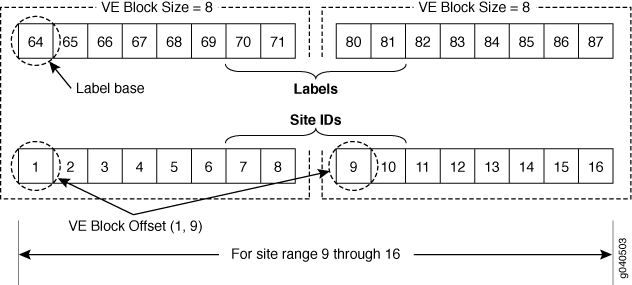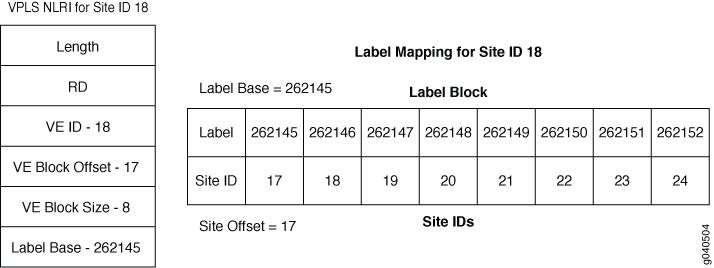VPLS Label Blocks Operation
A virtual private LAN service (VPLS) is a Layer 2 (L2) service that emulates a local area network (LAN) across a wide area network (WAN). VPLS labels are defined and exchanged in the Border Gateway Protocol (BGP) control plane. In the Junos OS implementation, label blocks are allocated and used in the VPLS control plane for two primary functions: autodiscovery and signaling.
-
Autodiscovery—A method for automatically recognizing each provider edge (PE) router in a particular VPLS domain, using BGP update messages.
-
Signaling—Each pair of PE routers in a VPLS domain sends and withdraws VPN labels to each other. The labels are used to establish and dismantle pseudowires between the routers. Signaling is also used to transmit certain characteristics of a pseudowire.
In the VPLS documentation, the word router in terms such as PE router is used to refer to any device that provides routing functions.
The PE router uses BGP extended communities to identify the members of its VPLS. Once the PE router discovers its members, it is able to establish and tear down pseudowires between members by exchanging and withdrawing labels and transmitting certain characteristics of the pseudowires.
The PE router sends common update messages to all remote PE routers, using a distinct BGP update message, thereby reducing the control plane load. This is achieved by using VPLS label blocks.
Elements of Network Layer Reachability Information
VPLS BGP network layer reachability information (NLRI) is used to exchange VPLS membership and parameters. The elements of a VPLS BGP NLRI are defined in Table 1.
|
Element |
Acronym |
Description |
Default Size (Octets) |
|---|---|---|---|
|
Length |
Total length of the NLRI size represented in bytes. |
2 |
|
|
Route Distinguisher |
RD |
Unique identifier for each routing instance configured on a PE. |
8 |
|
VPLS Edge ID |
VE ID |
Unique number to identify the edge site. |
2 |
|
VE Block Offset |
VBO |
Value used to identify a label block from which a label value is selected to set up pseudowires for a remote site. |
2 |
|
VE Block Size |
VBS |
Indicates the number of pseudowires that peers can have in a single block. |
2 |
|
Label Base |
LB |
Starting value of the label in the advertised label block. |
3 |
Requirements for NLRI Elements
Junos OS requires a unique route distinguisher (RD) for each routing instance configured on a PE router. A PE router might use the same RD across a VPLS (or VPN) domain or it might use different RDs. Using different RDs helps identify the originator of the VPLS NLRI.
The VPLS edge (VE) ID can be a unique VE ID, site ID, or customer edge (CE) ID. The VE ID is used by a VPLS PE router to index into label blocks used to derive the transmit and receive VPN labels needed for transport of VPLS traffic. The VE ID identifies a particular site, so it needs to be unique within the VPLS domain, except for some scenarios such as multihoming.
All PE routers have full mesh connectivity with each other to exchange labels and set up pseudowires. The VE block size (VBS) is a configurable value that represents the number of label blocks required to cover all the pseudowires for the remote peer.
A single label block contains 8 labels (1 octet) by default. The default VBS in Junos OS is 2 blocks (2 octets) for a total of 16 labels.
How Labels are Used in Label Blocks
Each PE router creates a mapping of the labels in the label block to the sites in a VPLS domain. A PE router advertising a label block with a block offset indicates which sites can use the labels to reach it. When a PE router is ready to advertise its membership to a VPLS domain, it allocates a label block and advertises the VPLS NLRI. In this way, other PE routers in the same VPLS domain can learn of the existence of the VPLS and set up pseudowires to it if needed. The VPLS NLRI advertised for this purpose is referred to as the default VPLS NLRI. The label block in the default VPLS NLRI is referred to as the default label block.
Label Block Composition
A label block (set of labels) is used to reach a given site ID. A single label block contains 8 labels (1 octet) by default. The VBS is 2 octets by default in Junos OS.
The label block advertised is defined as a label base (LB) and a VE block size (VBS). It is a contiguous set of labels (LB, LB+1,...LB+VBS-1). For example, when Router PE-A sends a VPLS update, it sends the same label block information to all other PE routers. Each PE router that receives the LB advertisement infers the label intended for Router PE-A by adding its own site ID to the label base.
In this manner, each receiving PE gets a unique label for PE-A for that VPLS. This simple method is enhanced by using a VE block offset (VBO).
A label block is defined as: <Label Base (LB), VE block offset (VBO), VE block size (VBS)> is the set {LB+VBO, LB+VBO+1,...,LB+VBO+VBS-1}.
Label Blocks in Junos OS
Instead of a single large label block to cover all VE IDs in a VPLS, the Junos OS implementation contains several label blocks, each with a different label base. This makes label block management easier, and also allows Router PE-A to seemlessly integrate a PE router joining a VPLS with a site ID not covered by the set of label blocks that Router PE-A has already advertised.
VPLS Label Block Structure
This section illustrates how a label block is uniquely identified.
A VPLS BGP NLRI with site ID V, VE block offset VBO, VE block size VBS, and label base LB communicates the following to its peers:
-
Label block for V: Labels from LB to (LB + VBS -1).
-
Remote VE set for V: from VBO to (VBO + VBS -1).
The label block advertised is a set of labels used to reach a given site ID. If there are several label blocks, the remote VE set helps to identify which label block to use. The example in Figure 1 illustrates label blocks. There are two blocks and each block has eight labels. In this example, the label values are 64 to 71 and 80 to 87.

To create a one-to-one mapping of these 16 labels to 16 sites, assume the site IDs are the numbers 1 to 16, as shown in the illustration. The site block indicates which site ID can use which label in the label block. So, in the first block, site ID 1 uses 64, site ID 2 uses 65, and so forth. Finally, site ID 8 uses 71. The 9th site ID will use the second block instead of the first block.
The labels are calculated by comparing the values of VBO <= Local site ID < (VBO +VBS). Consequently, site ID 9 uses 80, site ID 10 uses 81, and so on.
To further illustrate the one-to-one mapping of labels to sites, assume a label block with site offset of 1 and a label base of 10. The combination of label base and block offset contained in the VPLS NLRI provides the mapping of labels to site IDs. The block offset is the starting site ID that can use the label block as advertised in the VPLS NLRI.
To advertise the default VPLS NLRI, a PE router picks a starting block offset that fits its own site ID and is such that the end block offset is a multiple of a single label block. In Junos OS a single label block is eight labels by default.
The end block offset is the last site ID that maps to the last label in the label block. The end offset for the first block is 8 which maps to label 17 and the second block is 16. For example, a site with ID 3 picks a block offset of 1 and advertises a label block of size 8 to cover sites with IDs 1 to 8. A site with ID 10 picks a block offset of 9 to cover sites with IDs 9 to 16.
The VPLS NLRI shown in Figure 2 is for site ID 18. The label base contains value 262145. The block offset contains value 17. The illustration shows which site IDs correspond to which labels.

If a PE router configured with site ID 17 is in the same VPLS domain as a PE router configured with site ID 18, it receives the VPLS NLRI as shown in Figure 2. So it uses label 262145 to send traffic to site 18. Similarly, a PE router configured with site ID 19 uses label 262147 to send traffic to a PE router configured with site ID 18. However, only PE routers configured with site IDs 17 to 24 can use the label block shown to set up pseudowires.
